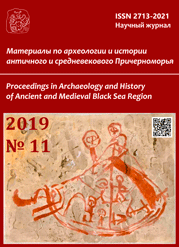Юлиан Апостат. Персидский поход и загадка битвы у Туммара 26 июня 363 г.
Julian the Apostate. The Persian campaign and the riddle of battle at Tummar of June 26, 363
Author(s): O. V. VusSubject(s): History, Ancient World
Published by: Нижневартовский государственный университет
Keywords: Julian the Apostate; strategic offensive operation; Persian Campaign; Mesopotamia; Maranga; battle at Tummar
Summary/Abstract: Based on the research and the analysis of some narrative sources, the article examines the final stage of the Roman-Iranian war of 338—363. The main component of this stage was the strategic offensive operation (the Persian Campaign), worked out and conducted by the Emperor Julian the Apostate. The research highlights Julian’s military-diplomatic, organizational and combative activities during the preparation and during the operation; a step-by-step analysis of the fighting in Mesopotamia from April to July 363 was performed. The issues of chronology and topography of the battles have been corrected and the peak of the combat tension, that occurred on June 25—26, 363 in the battles of Maranga and Tummar, has been determined. A hypothesis about the Julian’s injury in a fight with an Arab warrior of the Banu Tayi tribe and about the cause of the Emperor’s death, which occurred on the night of June 29, 363 has been put forward.The author states that as a result of the commander’s death and the loss of control, the strategic offensive operation of the Romans against Iran did not achieve its goal and ended with a complete military and moral-psychological defeat; with significant human and territorial losses of the Roman Empire in Mesopotamia.
Journal: Материалы по археологии и истории античного и средневекового Причерноморья
- Issue Year: 2019
- Issue No: 11
- Page Range: 271-299
- Page Count: 29
- Language: Russian

